The global electronic expansion valves market is projected to reach USD 1,986 million by 2035, recording an absolute increase of USD 1,099.5 million over the forecast period. The market is valued at USD 886.5 million in 2025 and is set to rise at a CAGR of 8.4% during the assessment period. The overall market size is expected to grow by 2.2 times during the same period, supported by increasing demand for energy-efficient HVAC systems worldwide, driving demand for advanced refrigeration control technologies and increasing investments in industrial automation and cooling system optimization projects globally. However, high initial costs and complex installation requirements may pose challenges to market expansion.
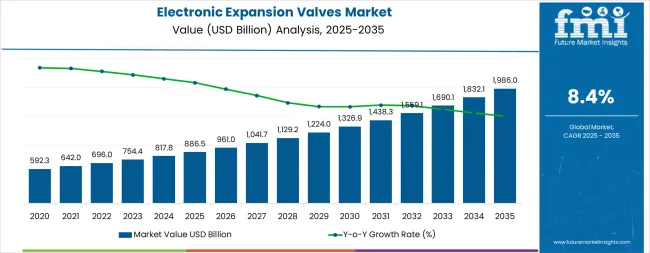
Between 2025 and 2030, the electronic expansion valves market is projected to expand from USD 886.5 million to USD 1,350.2 million, resulting in a value increase of USD 463.7 million, which represents 42.2% of the total forecast growth for the decade. This phase of development will be shaped by rising demand for energy-efficient HVAC systems and automotive air conditioning applications, product innovation in smart valve technologies and IoT integration systems, as well as expanding integration with alternative refrigerant systems and automated control initiatives. Companies are establishing competitive positions through investment in advanced electronic control technologies, precision flow management solutions, and strategic market expansion across industrial, commercial, and automotive applications.
From 2030 to 2035, the market is forecast to grow from USD 1,350.2 million to USD 1,986 million, adding another USD 635.8 million, which constitutes 57.8% of the overall ten-year expansion. This period is expected to be characterized by the expansion of specialized valve systems, including advanced smart control formulations and integrated monitoring solutions tailored for specific refrigeration requirements, strategic collaborations between valve manufacturers and HVAC system providers, and an enhanced focus on energy efficiency and environmental compliance optimization. The growing emphasis on alternative refrigerants and smart building integration will drive demand for advanced, high-performance electronic expansion valve solutions across diverse industrial and commercial applications.
| Metric | Value |
|---|---|
| Market Value (2025) | USD 886.5 million |
| Market Forecast Value (2035) | USD 1,986 million |
| Forecast CAGR (2025-2035) | 8.4% |
The electronic expansion valves market grows by enabling HVAC system manufacturers and facility operators to achieve superior energy efficiency and precise refrigerant control across multiple cooling applications, ranging from small-scale residential systems to large-scale industrial refrigeration complexes. System operators face mounting pressure to improve energy performance and operational efficiency, with electronic expansion valve solutions typically providing 15-30% improvement in energy efficiency compared to traditional thermostatic expansion valves, making advanced electronic control technology essential for competitive HVAC system performance. The cooling and refrigeration industry's need for maximum energy optimization creates demand for advanced valve solutions that can minimize energy consumption, enhance system reliability, and ensure consistent performance across diverse operating conditions and refrigerant types. Government initiatives promoting energy efficiency standards and environmental compliance drive adoption in industrial, commercial, and automotive applications, where cooling performance has a direct impact on operational costs and environmental footprint. However, high initial investment costs and the complexity of achieving optimal integration across different HVAC systems may limit adoption rates among cost-sensitive operators and regions with limited technical expertise.
The market is segmented by flow type, working pressure, material type, application, end user, and region. By flow type, the market is divided into electromagnetic expansion valves and electric expansion valves. Based on working pressure, the market is categorized into up to 30 bar, 30 to 50 bar, 50 to 200 bar, and above 200 bar. By material type, the market is classified into stainless steel, copper, and brass. By application, the market is divided into air conditioning, refrigeration, and others. By end user, the market is segmented into industrial facilities, commercial buildings, retail outlets and warehousing, residential buildings, and automotive. Regionally, the market is divided into North America, Latin America, Western Europe, Eastern Europe, East Asia, South Asia Pacific, and Middle East & Africa.
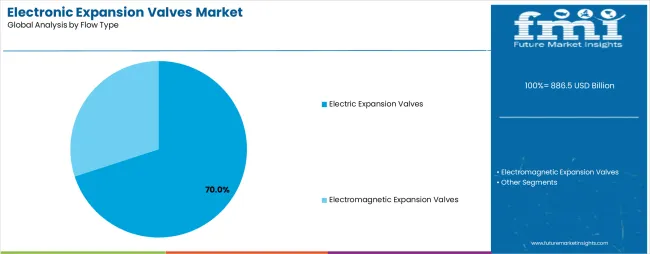
The electric expansion valves segment represents the dominant force in the electronic expansion valves market, capturing approximately 70.0% of total market share in 2025, projected to expand at a CAGR of 8.6% through 2035. This advanced flow control category encompasses formulations featuring precise electronic control capabilities, including real-time flow adjustment and intelligent monitoring systems that enable superior refrigerant management and enhanced energy efficiency characteristics. The electric expansion valves segment's market leadership stems from its exceptional performance capabilities in complex HVAC applications, with systems capable of providing precise flow control while maintaining consistent performance and energy optimization across diverse operating conditions.
The electromagnetic expansion valves segment maintains substantial market presence, serving applications that require cost-effective electronic control for standard refrigeration and air conditioning systems. These valves offer reliable performance for general-purpose cooling applications while providing sufficient accuracy to meet basic operational requirements in commercial and residential settings.
Key technological advantages driving the electric expansion valves segment include:
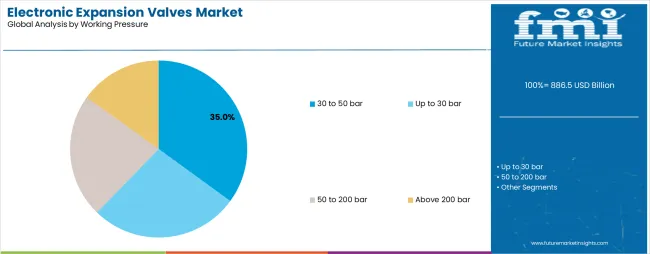
Working pressure segmentation addresses diverse application requirements across the electronic expansion valves market, with different pressure ranges serving specific cooling system needs. The up to 30 bar segment serves residential and light commercial applications, while 30 to 50 bar addresses standard commercial HVAC systems. The 50 to 200 bar segment caters to industrial refrigeration and specialized cooling applications, and above 200 bar serves high-pressure industrial processes and specialized refrigeration systems.
Each pressure segment reflects specific operational requirements and performance characteristics needed for optimal valve operation across different cooling system designs and refrigerant types. Market dynamics favor segments that provide reliable performance while meeting specific pressure requirements for targeted applications.
Key factors supporting working pressure segmentation include:
Material type segmentation demonstrates varying performance characteristics across the electronic expansion valves market, with stainless steel leading in high-performance applications requiring corrosion resistance and durability. Copper maintains strong presence in standard refrigeration applications due to its excellent thermal conductivity and cost-effectiveness, while brass serves specialized applications requiring specific mechanical properties.
Each material type offers distinct advantages in terms of corrosion resistance, thermal performance, and cost considerations, enabling manufacturers to optimize valve performance for specific application requirements and operating environments.
Key dynamics supporting material type performance include:
Air conditioning applications demonstrate strong market performance in the electronic expansion valves market, driven by growing HVAC system deployment and energy efficiency requirements. The air conditioning segment's established position reflects the critical importance of precise refrigerant control, energy optimization, and comfort management across residential, commercial, and automotive cooling systems.
Refrigeration applications show significant momentum through industrial cooling requirements, food processing systems, and cold storage facilities that demand reliable temperature control and energy efficiency. This segment benefits from continuous advancement in refrigeration technology that provides enhanced performance and environmental compliance.
The others segment captures specialized applications including heat pumps, chillers, and process cooling systems that require customized valve solutions for specific operational requirements.
Key factors supporting application advancement include:
Industrial facilities demonstrate strong market leadership in the electronic expansion valves market, projected to generate over USD 1,742.9 million in revenue by 2035, expanding at a CAGR of 9% through the forecast period. The industrial facilities segment's rapid growth reflects the critical role of process cooling, manufacturing climate control, and specialized refrigeration systems in driving valve demand across chemical, pharmaceutical, and food processing industries.
Commercial buildings show substantial market presence through HVAC system requirements, building automation integration, and energy efficiency initiatives that create demand for advanced electronic control solutions. This segment benefits from growing emphasis on smart building technologies and operational cost optimization.
Retail outlets and warehousing maintain significant market share through cold storage requirements and temperature-controlled logistics, while residential buildings and automotive segments serve consumer and transportation cooling applications respectively.
Key dynamics supporting industrial facilities growth include:
The market is driven by three concrete demand factors tied to energy efficiency and system performance outcomes. First, global energy efficiency regulations and HVAC modernization create increasing demand for high-performance electronic expansion valve solutions, with cooling systems consuming up to 50% of building energy, requiring advanced control technology for maximum efficiency optimization. Second, adoption of alternative refrigerants and environmental compliance drive the implementation of precise valve control technologies, with system operators seeking 15-30% improvement in energy efficiency and refrigerant management optimization. Third, technological advancements in IoT integration and smart control systems enable more effective and responsive valve solutions that reduce maintenance complexity while improving long-term performance and system intelligence.
Market restraints include high initial capital investment that can impact project feasibility and system upgrade costs, particularly during periods of economic constraints or operational budget limitations affecting HVAC system modernization. Technical complexity in system integration poses another significant challenge, as achieving optimal performance across different refrigerant types and system configurations demands specialized expertise and comprehensive calibration systems, potentially causing installation delays and increased commissioning costs. Skills shortage in electronic valve maintenance and calibration creates additional challenges for facility operators, demanding ongoing investment in training capabilities and compliance with varying regional HVAC standards.
Key trends indicate accelerated adoption in emerging markets, particularly China, India, and developing regions, where rapid industrialization and urbanization drive comprehensive HVAC system deployment with advanced electronic controls. Technology advancement trends toward AI integration with enhanced predictive analytics, energy optimization algorithms, and automated system adjustment capabilities enable next-generation product development that addresses multiple performance requirements simultaneously. However, the market could face disruption if alternative flow control technologies or significant changes in refrigeration practices minimize reliance on traditional electronic expansion valve solutions.
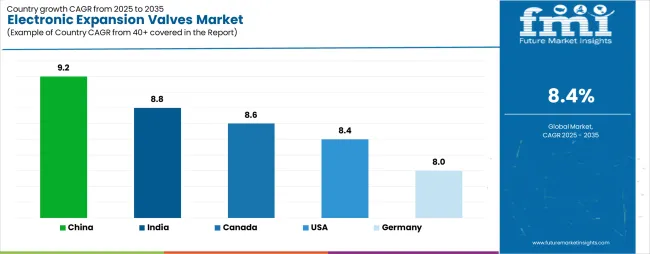
| Country | CAGR (2025-2035) |
|---|---|
| China | 9.2% |
| India | 8.8% |
| Canada | 8.6% |
| United States | 8.4% |
| Germany | 8% |
The electronic expansion valves market is gaining momentum worldwide, with China taking the lead thanks to massive HVAC industry expansion and comprehensive air conditioning market development. Close behind, India benefits from rapid industrialization and growing cooling system demand, positioning itself as a strategic growth hub in the Asian region. Canada shows steady advancement, where data center expansion and industrial cooling requirements strengthen its role in the North American HVAC technology development. The USA is focusing on energy efficiency improvements and smart building integration, signaling an ambition to capitalize on growing opportunities in advanced HVAC control technology markets. Meanwhile, Germany stands out for its industrial automation and precision engineering capabilities, recording consistent progress in electronic valve technology optimization. Together, China and India anchor the global expansion story, while the rest build stability and diversity into the market's growth path.
The report covers an in-depth analysis of 40+ countries; 5 top-performing countries are highlighted below.
China demonstrates the strongest growth potential in the Electronic Expansion Valves Market with a CAGR of 9.2% through 2035. The country's leadership position stems from massive air conditioning market expansion, government-backed industrial modernization programs, and comprehensive HVAC system deployment targets, driving the adoption of high-performance electronic expansion valve systems. Growth is concentrated in major industrial regions, including Guangdong, Jiangsu, Zhejiang, and Shandong, where manufacturers and facility operators are implementing advanced valve control solutions for enhanced energy performance and operational advantages. Distribution channels through established HVAC equipment suppliers and direct manufacturer relationships expand deployment across industrial facilities, commercial buildings, and automotive applications. The country's energy efficiency strategy provides policy support for advanced valve technology development, including high-performance electronic control platform adoption.
Key market factors:
In Mumbai, Delhi, Bangalore, and Chennai, the adoption of electronic expansion valve systems is accelerating across industrial facilities and commercial complexes, driven by cooling demand targets and comprehensive HVAC modernization initiatives. The market demonstrates strong growth momentum with a CAGR of 8.8% through 2035, linked to comprehensive industrial development and increasing focus on energy-efficient cooling solutions. Indian facility managers and HVAC operators are implementing advanced electronic valve systems and smart control platforms to enhance cooling performance while meeting growing energy efficiency requirements in domestic and commercial applications. The country's industrial expansion programs create demand for high-performance valve solutions, while increasing emphasis on data center cooling drives adoption of advanced electronic control technologies and precision refrigerant management systems.
Canada's advanced industrial sector demonstrates sophisticated implementation of electronic expansion valve systems, with documented case studies showing efficiency improvements in data center applications through optimized refrigerant control solutions. The country's cooling infrastructure in major industrial centers, including Ontario, Quebec, Alberta, and British Columbia, showcases integration of advanced valve technologies with existing HVAC systems, leveraging expertise in precision control engineering and energy management. Canadian facility operators emphasize energy efficiency and operational reliability, creating demand for high-performance electronic valve solutions that support climate goals and operational requirements. The market maintains steady growth through focus on industrial modernization and energy optimization, with a CAGR of 8.6% through 2035.
Key development areas:
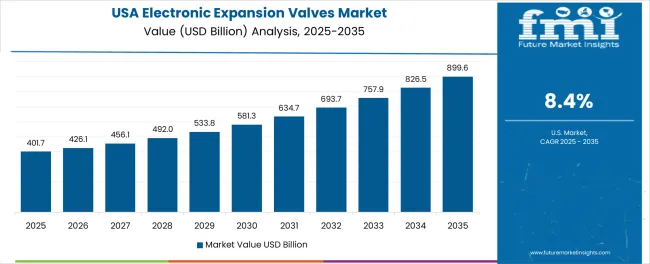
The USA's market expansion is driven by diverse cooling applications, including electronic valve deployment in Texas and California regions, data center development in Virginia and Washington, and comprehensive HVAC modernization across multiple industrial areas. The country demonstrates promising growth potential with a CAGR of 8.4% through 2035, supported by energy efficiency programs and regional cooling infrastructure initiatives. American facility operators face implementation challenges related to system integration and regulatory compliance requirements, requiring valve upgrade approaches and comprehensive technical support systems. However, growing energy efficiency targets and operational cost requirements create compelling business cases for electronic expansion valve adoption, particularly in industrial and commercial sectors where cooling performance has a direct impact on operational competitiveness.
Market characteristics:
Germany's market leads in industrial automation integration based on comprehensive precision engineering and sophisticated valve control applications for enhanced operational characteristics. The country shows solid potential with a CAGR of 8% through 2035, driven by Industry 4.0 programs and manufacturing excellence initiatives across major industrial regions, including North Rhine-Westphalia, Bavaria, Baden-Württemberg, and Lower Saxony. German manufacturers are adopting advanced electronic valve systems for process optimization and energy efficiency, particularly in regions with chemical processing and automotive manufacturing facilities requiring superior cooling control capabilities. Technology deployment channels through established automation companies and direct industrial relationships expand coverage across manufacturing facilities and commercial buildings.
Leading market segments:
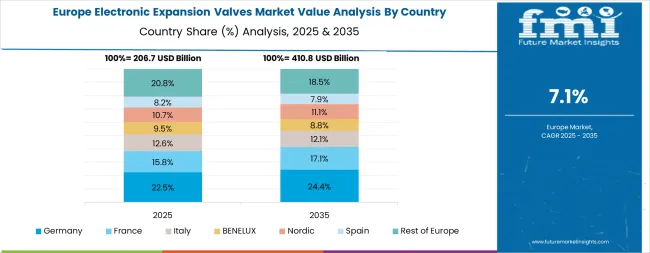
The electronic expansion valves market in Europe is projected to grow from USD 235.4 million in 2025 to USD 498.3 million by 2035, registering a CAGR of 7.8% over the forecast period. Germany is expected to maintain its leadership position with a 34.2% market share in 2025, declining slightly to 33.7% by 2035, supported by its extensive industrial infrastructure and major manufacturing centers, including North Rhine-Westphalia, Bavaria, and Baden-Württemberg technology hubs.
The United Kingdom follows with a 18.5% share in 2025, projected to reach 18.9% by 2035, driven by comprehensive building modernization programs and advanced HVAC initiatives implementing electronic valve technologies. France holds a 16.3% share in 2025, expected to maintain 16% by 2035 through ongoing industrial development and energy efficiency programs. Italy commands a 13.8% share, while Spain accounts for 9.7% in 2025. The Rest of Europe region is anticipated to gain momentum, expanding its collective share from 7.5% to 8.1% by 2035, attributed to increasing electronic expansion valve adoption in Nordic countries and emerging Eastern European industrial markets implementing advanced cooling control programs.
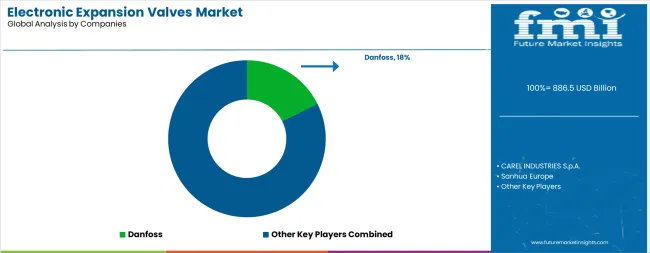
The electronic expansion valves market features approximately 15-20 meaningful players with moderate concentration, where the top three companies control roughly 40-45% of global market share through established valve technology platforms and extensive HVAC industry relationships. Competition centers on technological innovation, precision control capabilities, and comprehensive system integration rather than price competition alone.
Market leaders include Danfoss, CAREL INDUSTRIES S.p.A., and Sanhua Europe, which maintain competitive advantages through comprehensive valve solution portfolios, global service networks, and deep expertise in the HVAC control and refrigeration sectors, creating high switching costs for customers. These companies leverage research and development capabilities and ongoing technical support relationships to defend market positions while expanding into adjacent smart building and IoT integration applications.
Challengers encompass Parker-Hannifin Corporation and Emerson Electric Co., which compete through specialized valve solutions and strong regional presence in key industrial markets. Technology specialists, including VOLGA, Zhejiang DUNAN Artificial Environment Co., and Fujikoki Corporation, focus on specific applications or vertical markets, offering differentiated capabilities in precision control, automotive applications, and specialized refrigeration systems.
Regional players and emerging valve technology providers create competitive pressure through innovative solutions and rapid customization capabilities, particularly in high-growth markets including China, India, and developing regions, where local presence provides advantages in regulatory compliance and system integration. Market dynamics favor companies that combine advanced electronic valve technologies with comprehensive service offerings that address the complete cooling system lifecycle from design through ongoing performance optimization.
Electronic expansion valves represent advanced control technologies that enable HVAC system operators to achieve 15-30% improvement in energy efficiency compared to traditional thermostatic expansion valves, delivering superior cooling performance and operational optimization with enhanced refrigerant management capabilities in demanding industrial and commercial applications. With the market projected to grow from USD 886.5 million in 2025 to USD 1,986 million by 2035 at a 8.4% CAGR, these control systems offer compelling advantages - enhanced energy efficiency, customizable flow control configurations, and intelligent monitoring integration - making them essential for industrial facilities, commercial buildings, and automotive applications seeking alternatives to inefficient manual valve systems that compromise performance through imprecise refrigerant control and higher energy consumption. Scaling market adoption and technological advancement requires coordinated action across HVAC regulations, energy efficiency standards development, valve manufacturers, cooling system operators, and energy optimization investment capital.
How Governments Could Spur Local Production and Adoption?
How Industry Bodies Could Support Market Development?
How OEMs and Technology Players Could Strengthen the Ecosystem?
How Suppliers Could Navigate the Shift?
How Investors and Financial Enablers Could Unlock Value?
| Items | Values |
|---|---|
| Quantitative Units | USD 886.5 Million |
| Flow Type | Electromagnetic Expansion Valves, Electric Expansion Valves |
| Working Pressure | Up to 30 bar, 30 to 50 bar, 50 to 200 bar, Above 200 bar |
| Material Type | Stainless Steel, Copper, Brass |
| Application | Air Conditioning, Refrigeration, Others |
| End User | Industrial Facilities, Commercial Buildings, Retail Outlets and Warehousing, Residential Buildings, Automotive (OEM, Aftermarket) |
| Regions Covered | North America, Latin America, Western Europe, Eastern Europe, East Asia, South Asia Pacific, Middle East & Africa |
| Country Covered | China, India, Canada, USA, Germany, and 40+ countries |
| Key Companies Profiled | Danfoss, CAREL INDUSTRIES S.p.A., Sanhua Europe, VOLGA, Parker-Hannifin Corporation, Emerson Electric Co., Zhejiang DUNAN Artificial Environment Co., Fujikoki Corporation |
| Additional Attributes | Dollar sales by flow type, working pressure, material type, application, and end user categories, regional adoption trends across East Asia, North America, and Western Europe, competitive landscape with valve technology providers and HVAC system integrators, operational requirements and specifications, integration with energy efficiency initiatives and smart cooling systems, innovations in electronic control technology and monitoring systems, and development of specialized configurations with precision and reliability capabilities. |
The global electronic expansion valves market is estimated to be valued at USD 886.5 billion in 2025.
The market size for the electronic expansion valves market is projected to reach USD 1,986.0 billion by 2035.
The electronic expansion valves market is expected to grow at a 8.4% CAGR between 2025 and 2035.
The key product types in electronic expansion valves market are electric expansion valves and electromagnetic expansion valves.
In terms of working pressure, 30 to 50 bar segment to command 35.0% share in the electronic expansion valves market in 2025.






Full Research Suite comprises of:
Market outlook & trends analysis
Interviews & case studies
Strategic recommendations
Vendor profiles & capabilities analysis
5-year forecasts
8 regions and 60+ country-level data splits
Market segment data splits
12 months of continuous data updates
DELIVERED AS:
PDF EXCEL ONLINE
Electronic Weighing Scale Market Size and Share Forecast Outlook 2025 to 2035
Electronic Film Market Size and Share Forecast Outlook 2025 to 2035
Electronic Packaging Adhesives Market Forecast and Outlook 2025 to 2035
Electronic Sealants Market Size and Share Forecast Outlook 2025 to 2035
Electronic Nasal Spray Devices Market Size and Share Forecast Outlook 2025 to 2035
Electronics Adhesives Market Size and Share Forecast Outlook 2025 to 2035
Electronic Tactile Tester Market Size and Share Forecast Outlook 2025 to 2035
Electronic Trial Master File (eTMF) System Market Size and Share Forecast Outlook 2025 to 2035
Electronic Wipes Market Size and Share Forecast Outlook 2025 to 2035
Electronic Grade Trisilylamine Market Size and Share Forecast Outlook 2025 to 2035
Electronically Scanned Arrays System Market Size and Share Forecast Outlook 2025 to 2035
Electronics Retailing Market Size and Share Forecast Outlook 2025 to 2035
Electronic Dictionary Market Size and Share Forecast Outlook 2025 to 2035
Electronic Shelf Label Market Analysis - Size, Share, and Forecast Outlook 2025 to 2035
Electronics Films Market Size and Share Forecast Outlook 2025 to 2035
Electronic Payment System For Transportation Market Size and Share Forecast Outlook 2025 to 2035
Electronic Skin Market Analysis - Size, Share, and Forecast Outlook 2025 to 2035
Electronic Ceramics Market Size and Share Forecast Outlook 2025 to 2035
Electronic Equipment Repair Service Market Analysis - Size, Share, and Forecast 2025 to 2035
Electronic Logging Device Market Size and Share Forecast Outlook 2025 to 2035

Thank you!
You will receive an email from our Business Development Manager. Please be sure to check your SPAM/JUNK folder too.
Chat With
MaRIA